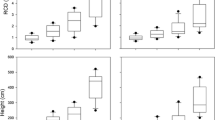Summary
In this study we compared the aboveground growth rates of two exotic shrubs (Rhamnus cathartica and Lonicera X bella) and two native shrubs (Cornus racemosa and Prunus serotina) that are important in southern Wisconsin hardwood forests. For all species except P. serotina, aboveground growth rates in an open habitat were greater than in an understory environment. Growth rates differed among species in the open habitat and were significantly correlated with woody production per unit leaf area. All species had greater leaf area per unit wood biomass in the understory than in the open habitat. A comparison of above-ground growth and annual carbon gain suggests much greater respiratory costs in the open habitat, especially for P. serotina. The data from this study were used to examine mechanisms of species response to different light availabilities. We found that the species that increased their production per unit leaf area in response to increased light did not increase their leaf area per unit wood biomass in response to low light, and vice versa. Production of proportionately high leaf area may be important for the growth of C. racemosa in low light.
Similar content being viewed by others
References
Auclair AN, Cottam G (1971) Dynamics of black cherry (Prunus serotina Erhr) in southern Wisconsin oak forests. Ecol Monogr 41:153–177
Barnes WJ (1972) The autecology of the Lonicera X bella complex. Dissertation. University of Wisconsin, Madison, WI
Baskerville GL (1972) Use of logarithmic regression in the estimation of plant biomass. Can J For Res 2:49–53
Bazzaz FA (1986) Life history of colonizing plants: some demographic, genetic, and physiological features. In: Mooney HA, Drake JA (eds) Ecology of biological invasions of North America and Hawaii. Springer-Verlag, New York, pp 96–110
Beadle CL (1985) Plant growth analysis. In: Coombs J, Hall DO, Long SP, Scurlock JMO (eds) Techniques in bioproductivity and photosysthesis. Pergamon Press, New York, pp 20–25
Binkley D, Lousier JD, Cromack K (1984) Ecosystem effects of sitka alder in a Douglas-fir plantation. Forest Science 30:26–35
Blackman GE, Wilson GL (1951) Physiological and ecological studies in the analysis of plant environment. VII. An analysis of the differential effects of light intensity on the net assimilation rate, leaf-area ratio, and relative growth rate of different species. Ann Bot NS 15:373–408
Braun EL (1950) The deciduous forests of North America. Blackiston and Company, Philadelphia, PA
Brown JK (1976) Estimating shrub biomass from basal stem diameters. Can J For Res 6:153–158
Curtis JT (1959) The vegetation of Wisconsin. The University of Wisconsin Press, Madison, WI
Easterly NW (1979) Non-indigenous plant species in the oak openings of northwestern Ohio. Castanea 44:142–149
Gourley LC (1985) A study of the ecology and spread of buckthorn (Rhamnus cathartica L.) with particular reference to the University of Wisconsin Arboretum. MS Thesis. University of Wisconsin, Madison, WI
Grigal DF, Ohmann LF (1977) Biomass estimation for some shrubs from northeastern Minnesota. USDA For Serv Research Note NC-226. NC Forest Experiment Station, St. Paul MN
Harrington RA (1984) Environmental controls on clonal willow growth. MS Thesis. University of Wisconsin, Madison, WI
Harrington RA, Brown BJ, Reich PB (1989) Ecophysiology of exotic and native shrubs in southern Wisconsin: I. Relationship of leaf characteristics, resource availability, and phenology to seasonal patterns of carbon gain. Oecologia 80:356–367
Jach M (1985) Ecology and distribution of the exotic shrub buckthorn in the University of Wisconsin Arboretum. Senior Thesis, University of Wisconsin, Madison, WI
Kline V (1981) Control of honeysuckle and buckthorn in oak forests. Restoration and Management Notes 1:18
Leopold A, Jones E (1947) A phenological record for Sauk and Dane Counties, Wisconsin. Ecol Monogr 17:83–122
National Climatic Data Center, Asheville NC (1987) Local Climatological Data, Madison, Wisconsin 1986: annual summary with comparative data
Newbould PJ (1967) Methods for estimating the primary production of forests. IBP Handbook No. 2. Blackwell Scientific Publications, Oxford
Newsome AE, Noble IR (1986) Ecological and physiological characters of invading plant species. In: Groves RH, Burdon JJ (eds) Ecology of biological invasions. Cambridge University Press, Cambridge, pp 1–17
Nowak MM (1976) The effect of human disturbance on vegetation at the Wehr Nature Center in Whitnall Park. UW-Milwaukee Field Stat Bull 9:1–7
Radford PJ (1967) Growth analysis formulae-their use and abuse. Crop Science 7:171–175
Rehder A (1936) On the history of the introduction of woody plants into North America. Natl Hort Mag 15:245–257
Roussopoulos PJ, Loomis RM (1979) Weights and dimensional properties of shrubs and small trees of the Great Lakes conifer forest. US Dept Agric For Ser, Research Paper NC-178. NC Forest Experiment Station, St. Paul, MN, p 6
Sprugel DG (1983) Correcting for bias in log-transformed allometric equations. Ecology 64:209–210
Telfer ES (1969) Weight-diameter relationships for 22 woody plant species. Can J Bot 47:1851–1855
Vitousek PM (1986) Biological invasions and ecosystem properties: can species make a difference? IN: Mooney HA, Drake JA (eds) Ecology of biological invasions of North America and Hawaii. Springer, Berlin Heidelberg New York, pp 163–176
Wadmond SC (1910) Flora of Racine and Kenosha Counties, Wisconsin. Transact Wisconsin Acad Sci Arts Lett 16:798–888
Waring RH (1983) Estimating forest growth and efficiency in relation to canopy leaf area. Ady Ecol Res 13:327–354
Weiss PW, Noble IR (1984) Interactions between seedlings of Chrysantemoides and Acacia longifolia. Austr J Ecol 9:107–115
Whittaker RH, Marks PL (1975) Methods of assessing terrestrial productivity. In: Leith H, Whittaker RH (eds) Primary Productivity of the Biosphere. Springer, Berlin Heidelberg New York, pp 55–117
Author information
Authors and Affiliations
Rights and permissions
About this article
Cite this article
Harrington, R.A., Brown, B.J., Reich, P.B. et al. Ecophysiology of exotic and native shrubs in Southern Wisconsin. Oecologia 80, 368–373 (1989). https://doi.org/10.1007/BF00379038
Received:
Issue Date:
DOI: https://doi.org/10.1007/BF00379038




